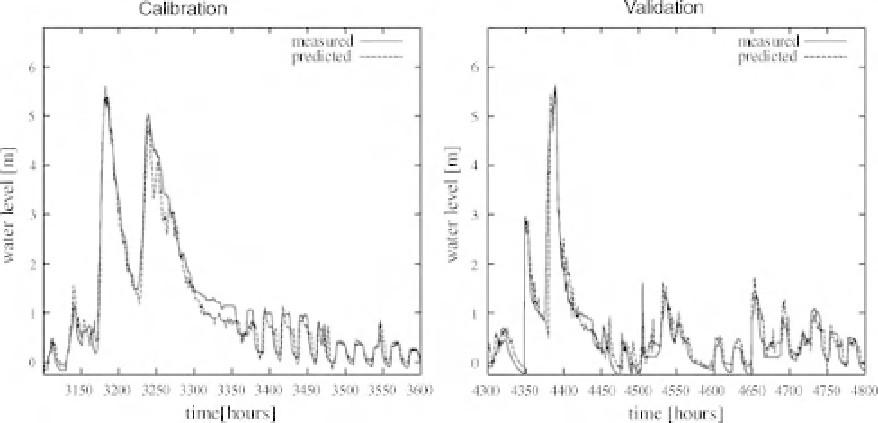Geoscience Reference
In-Depth Information
Figure 4.12
Application of a neural network to forecasting flows in the River Arno catchment, northern Italy:
one- and six-hour-ahead forecasts are based on input data of lagged rainfalls, past discharges, and power
production information; the influence of power production on the flow is evident in the recession periods
(after Campolo et al., 2003, with kind permission of Taylor and Francis).
return period peak discharge for ungauged basins as an alternative to a multiple regression approach
(Muttiah
et al.
, 1997).
Overparameterisation of neural net models relative to the information in the learning set is an issue with
this type of model (as in any empirical model). The danger of overparameterisation is that, in general, it
will lead to greater uncertainty in prediction or extrapolation, particularly in prediction or extrapolation
beyond the range of the learning or calibration set. A good performance in fitting the learning set does
not guarantee a good performance in prediction when the conditions go outside the range seen in the
learning set (e.g. Cameron
et al.
, 2002; Gaume and Gosset, 2003; Han
et al.
2007). As yet, there has been
little work in the hydrological literature on estimating the uncertainties associated with the predictions of
ANN models (but see, for example, Khan and Coulilaby, 2006). Neural networks have also been used as
emulators of more complex hydrological and hydrodynamic models (Dibike
et al.
, 1999; Abrahart and
See, 2007).
4.6.2 Support Vector Machines (SVM)
An alternative approach to determining a predictive model from data is the use of support vector machines
(SVM; Vapnik, 1995; Cristianini and Shawe-Taylor, 2000). This approach was also developed in the
field of artificial intelligence as a way of interpreting sensor data and involves a two-layer structure.
The first layer is a nonlinear kernel weighting on the input variable series (the support vectors) and the
second is a weighted sum of the kernel outputs. It has automatic procedures for deciding on a minimal
set of support vectors and for determining the kernel weighting coefficients. Its advantages over ANN
methods are that the fitting of the model, once the support vectors and appropriate kernel filters have been
determined, is less likely to be over-parameterised (Bray and Han, 2004). Performance has generally
been reported to be equal to or better than the results of neural network models. Disadvantages of the
method include handling the large matrices of support vectors (which include longer time series than

